New Zealanders
New Zealanders, colloquially known as Kiwis[10][11] (/kiːwiː/),[12] are people associated with New Zealand, sharing a common history, culture, and language (New Zealand English and or Māori language). People of various ethnicities and national origins are citizens of New Zealand, governed by its nationality law.
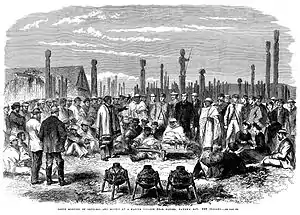 | |
| Total population | |
|---|---|
| c. 5.5 million | |
| Regions with significant populations | |
| c. 5,080,000 | |
| 640,770[1] | |
| 58,286[2] | |
| 22,872[2] | |
| 15,395[3] | |
| 4,260[2] | |
| 4,000[4] | |
| 3,146[2] | |
| 3,000[5] | |
| 2,631[6][7] | |
| 2,195[2] | |
| 890[2] | |
| 303[8] | |
| Languages | |
| English · Te Reo Māori · Other minority languages | |
| Religion | |
| Christianity (Anglican, Protestantism, Roman Catholicism) Other minority religions[9] | |
| Related ethnic groups | |
| Australians Norfolk Islanders Cook Islanders Niueans Fijians | |
Originally composed solely of the indigenous Māori, the ethnic makeup of the population has been dominated since the 19th century by New Zealanders of European descent, mainly of Scottish, English, Welsh and Irish ancestry, with smaller percentages of other European ancestries such as Greek, Italian, German, Dutch, Scandinavian and South Slavic. Today, the ethnic makeup of the New Zealand population is undergoing a process of change, with new waves of immigration, higher birth rates and increasing interracial marriage resulting in the New Zealand population of Māori, Asian, Pacific Islander and multiracial descent growing at a higher rate than those of solely European descent, with such groups projected to make up a larger proportion of the population in the future.[13] New Zealand has an estimated resident population of around 5,084,300 (as of June 2020).[14] Over one million New Zealanders recorded in the 2013 New Zealand census were born overseas.[15]
While most New Zealanders are resident in New Zealand, there is also a significant diaspora, estimated at around 750,000. Of these, around 640,800 lived in Australia (a June 2013 estimate),[1] which was equivalent to 13% of the resident population of New Zealand. Other communities of New Zealanders abroad are heavily concentrated in other English-speaking countries, specifically the United Kingdom, the United States and Canada, with smaller numbers located elsewhere.[2]
Despite its multiethnic composition, the culture held in common by most New Zealanders can also be referred to as mainstream New Zealand culture, a Western culture largely derived from the traditions of British and other Northern European colonists, settlers, and immigrants. It also includes influences of Māori culture. Large-scale immigration in the 20th and 21st centuries from Asia, such as Chinese and Indians, introduced a variety of elements.
Ethnic origins
| 1961 New Zealand census[16][17] | |||||
|---|---|---|---|---|---|
| Ethnic group | Population | % of New Zealand population | |||
| European | 2,216,886 | 91.8 | |||
| Māori | 167,086 | 6.9 | |||
| Other | 31,012 | 1.3 | |||
| Total | 2,414,984 | 100 | |||
| 2013 New Zealand census[18][19] | |||||
| Ethnic group | Population | % of New Zealand population | |||
| European | 2,969,391 | 74.0 | |||
| Māori | 598,602 | 14.9 | |||
| Asian | 471,708 | 11.8 | |||
| Pacific Islander | 295,941 | 7.4 | |||
| ME/LA/African | 46,956 | 1.2 | |||
| Other | 67,752 | 1.7 | |||
| Total | 4,242,048 | 100 | |||
The table above shows the broad ethnic composition of the New Zealand population at the 1961 census compared to that from the most recent data of the 2013 census. People of European descent constituted the majority of the 4.2 million people living in New Zealand, with 2,969,391 or 74.0% of the population in the 2013 New Zealand census.[19] Those of full or part-Māori ancestry comprise 14.9% of New Zealanders. The residual "others" ethnic group consists largely of Asians and Pacific Islanders.[16]
.jpg.webp)
European

Most European New Zealanders have British and/or Irish ancestry, with smaller percentages of other European ancestries such as Germans, Poles (historically noted as "Germans" due to Partitions of Poland), French, Dutch, Scandinavian and South Slavs.[20] In the 1961 census, over 90% of New Zealanders self-identified as people of European descent.[16]
The Māori-language loanword Pākehā came into use to refer to European New Zealanders, although some European New Zealanders reject this appellation.[21][22] Twenty-first century New Zealanders increasingly use the word "Pākehā" to refer to all non-Polynesian New Zealanders.[23]
The first Europeans known to have reached New Zealand were the Dutch explorer Abel Janszoon Tasman and his crew in 1642.[24] Māori killed several of the crew, and no more Europeans went to New Zealand until British explorer James Cook's voyage of 1768–71.[24] Cook reached New Zealand in 1769 and mapped almost the entire coastline. Following Cook, New Zealand was visited by numerous European and North American whaling, sealing, exploring and trading ships. They traded European food and goods, especially metal tools and weapons, for Māori timber, food, artefacts and water. On occasion, Europeans and Māori traded goods for sex.[25] Some early European arrivals integrated closely with the indigenous Māori people and became known as Pākehā Māori. James Belich characterises many of the very early European settlers as forerunners of a "crew culture" - as distinct from the majority of later European immigrants.[26]

Becoming aware of the lawless nature of European settlement and of increasing French interest in the territory, the British government appointed James Busby as British Resident to New Zealand in 1832. Busby failed to bring law and order to European settlement, but did oversee the introduction of the first national flag on 20 March 1834, after an unregistered New Zealand ship was seized in Australia. The nebulous United Tribes of New Zealand later, in October 1835, sent the Declaration of the Independence of New Zealand to King William IV of the United Kingdom, asking him for protection. Ongoing unrest and the legal standing of the Declaration of Independence prompted the Colonial Office to send Captain William Hobson to New Zealand to claim sovereignty for the British Crown and negotiate a treaty with the Māori.[i] The two parties first signed the Treaty of Waitangi in the Bay of Islands on 6 February 1840.[27] The drafting was done hastily and confusion and disagreement continue to surround the translation. However, New Zealanders still regard "the Treaty" as marking New Zealand's foundation as a nation, and Māori revere it as a guarantee of their rights.
In response to attempts by the New Zealand Company to establish a separate colony in Wellington, and mindful of French claims in Akaroa, Hobson, appointed as Lieutenant-Governor on 14 January 1840, declared British sovereignty over all of New Zealand on 21 May 1840. He published two proclamations published in the New Zealand Advertiser and Bay Of Islands Gazette issue of 19 June 1840. One "assert[s] on the grounds of Discovery, the Sovereign Rights of Her Majesty over the Southern Islands of New Zealand, commonly called 'The Middle Island' (South Island) and 'Stewart's Island' (Stewart Island/Rakiura); and the Island, commonly called 'The Northern Island', having been ceded Sovereignty to Her Majesty". The second proclamation expanded on how sovereignty over the "Northern Island" had been ceded under the treaty signed that February.[28]
Following the formalising of sovereignty, an organised and structured flow of migrants from Great Britain and Ireland began, and by 1860 more than 100,000 British and Irish settlers lived throughout New Zealand. The Otago Association actively recruited settlers from Scotland, generating a definite Scottish influence in Murihiku, while the Canterbury Association recruited settlers from the south of England, giving a definite English influence to the "Canterbury Settlement".[29] By 1870 the non-Māori population reached over 250,000.[30]
Other settlers came from Germany, Scandinavia, and other parts of Europe as well as from China and the Indian subcontinent, but British and Irish settlers made up the vast majority, and did so for the next 150 years.[11]
Between 1881 and the 1920s, the New Zealand Parliament passed legislation that intended to limit Asiatic migration to New Zealand, and prevented Asians from naturalising.[31] In particular, the New Zealand government levied a poll tax on Chinese immigrants up until the 1930s, when Japan went to war with China. New Zealand finally abolished the poll tax in 1944. An influx of Jewish refugees from central Europe came in the 1930s. Many of the persons of Polish origin in New Zealand arrived as orphans from Eastern Poland via Siberia and Iran in 1944 during World War II.[32]
Post-Second World War European immigration

With the agencies of the United Nations dealing with humanitarian efforts following the Second World War, New Zealand accepted about 5,000 refugees and displaced persons from Europe, and more than 1,100 Hungarians between 1956 and 1959 (see Refugees in New Zealand). The post-WWII immigration included more persons from Greece, Italy, Poland and the former Yugoslavia.
New Zealand limited immigration to those who would meet a labour shortage in New Zealand. To encourage those to come, the Government introduced free and assisted passages in 1947, a schema expanded by the First National Government in 1950. However, when it became clear that not enough skilled migrants would come from the British Isles alone, recruitment began in Northern European countries. New Zealand signed a bilateral agreement for skilled migrants with the Netherlands, and a large number of Dutch immigrants arrived in New Zealand. Others came in the 1950s from Denmark, Germany, Switzerland and Austria to meet needs in specialised occupations. By the 1960s, the policy of excluding people based on nationality yielded a population overwhelmingly European in origin. By the mid-1960s, a desire for cheap unskilled labour led to ethnic diversification.
Māori
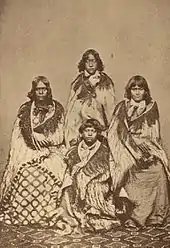
The Māori people are most likely descended from people who emigrated from Taiwan to Melanesia and then travelled east through to the Society Islands.[33] After a pause of 70 to 265 years, a new wave of exploration led to the discovery and settlement of New Zealand in about AD 1250–1300,[34] making New Zealand one of the most recently settled major landmasses. Some researchers have suggested an earlier wave of arrivals dating to as early as AD 50–150; these people then either died out or left the islands.[35][36][37]
Over the following centuries the Polynesian settlers developed into a distinct culture now known as Māori. The population was divided into iwi (tribes) and hapū (subtribes) which would cooperate, compete and sometimes fight with each other. At some point a group of Māori migrated to the Chatham Islands where they developed their distinct Moriori culture.[38][39]
Due to New Zealand's geographic isolation, 500 years passed before the next phase of settlement, the arrival of Europeans. Only then did the indigenous inhabitants need to distinguish themselves from the new arrivals, using the term "Māori" which means "normal" or "ordinary".[40]

In the 1860s, disputes over questionable land purchases led to the Māori Wars, which resulted in large tracts of tribal land being confiscated by the colonial government. Settlements such as Parihaka in Taranaki have become almost legendary because of injustices done there.[41] With the loss of much of their land, Māori went into a period of decline, and in the late 19th century it was believed that the Māori population would cease to exist as a separate race and would be assimilated into the European population.
However, the predicted decline did not occur, and numbers recovered. Despite a high degree of intermingling between the Māori and European populations, Māori were able to retain their cultural identity and in the 1960s and 1970s Māoridom underwent a cultural revival.[42]

The Māori population has seen stability in the 21st century. In the 2013 Census, 598,602 people identified as being part of the Māori ethnic group, accounting for 14.9%[18] of the New Zealand population, while 668,724 people (17.5%) claimed Māori descent.[18] 278,199 people identified as of sole Māori ethnicity, while 291,015 identified as of both European and Māori ethnicity (with or without a third ethnicity), due to a high rate of intermarriage between the two cultures.[43] Under the Maori Affairs Amendment Act 1974, a Māori is defined as “a person of the Māori race of New Zealand; and includes any descendant of such a Māori."
According to the 2006 census, the largest iwi by population is Ngāpuhi (125,601), followed by Ngāti Porou (71,049), Ngāi Tahu (54,819) and Waikato (40,083). However, over 110,000 people of Māori descent in the 2013 census could not identify their iwi.[18] Outside of New Zealand, a large Māori population exists in Australia, estimated at 155,000 in 2011.[44] The Māori Party has suggested a special seat should be created in the New Zealand parliament representing Māori in Australia.[45] Smaller communities also exist in the United Kingdom (approx. 8,000), the United States (up to 3,500) and Canada (approx. 1,000).[46][47]
The most common region this group lived in was Auckland Region (23.9 percent or 142,770 people). They are the second-largest ethnic group in New Zealand, after European New Zealanders. In addition, more than 120,000 Māori live in Australia. The Māori language (known as Te Reo Māori) is still spoken to some extent by about a fifth of all Māori, representing 3% of the total population. Many New Zealanders regularly use Māori words and expressions, such as "kia ora", while speaking English. Māori are active in all spheres of New Zealand culture and society, with independent representation in areas such as media, politics and sport.
Asian

In the 2013 Census, Asian ancestries total was 11.8% of the population, Chinese remained the largest Asian ethnic group in 2013, with 171,411 people while Indian was the second-largest Asian ethnic group in 2013, with 155,178 with Filipino a distant third with 40,350 people.[18]
The Asian component actually predates the Pacific component. There had been people of Asian ethnicity living in New Zealand from the early days of European settlement, albeit in very small numbers. During the period of gold rushes later in the nineteenth century the number of Chinese temporary settlers both from China and from Australia and America increased sharply. This was an interlude in many respects, though there was a small population which remained and settled permanently. However, a century later in the 1980s and 1990s the number of people of Asian ethnicities grew rapidly, and they are likely to exceed the Pacific population within the next few years.
Pacific Islanders
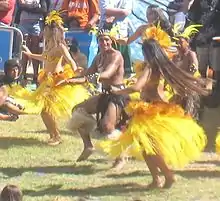
In the 1950s and 1960s, New Zealand encouraged migrants from the South Pacific.[48] The country had a large demand for unskilled labour in the manufacturing sector. As long as this demand continued, migrants were encouraged by the government to come from the South Pacific, and many overstayed. However, when the boom times stopped, some blamed the migrants for the economic downturn affecting the country, and many of those people suffered dawn raids from 1974.
Middle Eastern, Latin American and African
This component was 1.2% of the total population in the 2013 census.[18] The Latin American ethnic group almost doubled in size between the 2006 and 2013 censuses, increasing from 6,654 people to 13,182. A more recent component comprises refugees and other settlers from Africa and the Middle East, most recently from Somalia. While there had been previous settlers from the Middle East, such as Syrians, people from Equatorial Africa have been very few in the past.
- Middle Eastern ethnic group – 20,406
- African ethnic group – 13,464
Race and ethnic relations

Successive government policies on the relationship between Māori and non-Māori people have worsened race relations. After 1840, many issues to do with sovereignty and land ownership remained unresolved and, for a long time, invisible while Māori lived in rural communities. When Māori and Pākehā began living in closer proximity, the belief that the country had "the best race relations in the world" was tested. The first Race Relations Concilitator was appointed in 1971 to help combat racial discrimination among New Zealanders.[50]
Agitation regarding Treaty of Waitangi violations intensified in the 1970s. The Waitangi Tribunal was set up in 1975 to consider alleged breaches, and in 1984 was empowered to look back to 1840.[51]
Culture
New Zealand culture is essentially a Western culture influenced by the unique environment and geographic isolation of the islands, and the cultural input of the Māori and the various waves of multiethnic migration which followed the British colonisation of New Zealand. British settlers brought a legal, political, and economic system that has flourished, along with the British system of agriculture that has transformed the landscape. The British brought the Protestant work ethic—the industrious newcomers astonished Māori people. In return, settlers noted the athletic ability, musicality, and courage of the Māori.
The development of a New Zealand identity and national character, separate from the British colonial identity, is most often linked with the period surrounding the First World War, which gave rise to the concept of the Anzac spirit.[52] However, cultural links between New Zealand and Great Britain are maintained by a common language, sustained immigration from the UK, and the fact that many young New Zealanders spend time in Britain on "overseas experience", known as "OE".[53] New Zealanders also identify closely with Australians, as a result of the two nations' shared historical, cultural and geographic characteristics.[54]

The New Zealand government promotes Māori culture by supporting Māori-language schools, by ensuring the language is visible in government departments and literature, by insisting on traditional Māori welcomes (pōwhiri) at government functions and state school award programs,[55] and by having Māori run the welfare services targeted at their people.[56]
New Zealanders are distinctive for their twangy dialect of English and propensity to travel long distances, and are quickly associated with the All Blacks rugby team and the haka. A tradition of resourcefulness came from the pioneering backgrounds of both European and Māori colonists.
National personifications
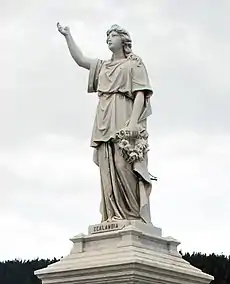
Zealandia is a national personification of New Zealand and New Zealanders. In her stereotypical form, Zealandia appears as a woman of European descent who is dressed in flowing robes (or gown).[57][58] She is similar in dress and appearance to Britannia (the female personification of Britain), who is said to be the mother of Zealandia.[58]
As a rhetorical evocation of a New Zealand national identity,[57] Zealandia appeared on postage stamps, posters, cartoons, war memorials, and New Zealand government publications most commonly during the first half of the 20th century. The personification was a commonly used symbol of the New Zealand Centennial Exhibition, which was held in Wellington in 1939 and 1940.[57] Two large Zealandia statues serve as war memorials that honour the casualties of the Second Boer War: one is in Waimate and the other is in Palmerston.[57] Some smaller statues exist in museums and in private hands.
The female figure who appears on the left side of the national coat of arms has been identified as Zealandia[59] (in a "cut down nightie").[58]
Language
English (New Zealand English) is the dominant language spoken by New Zealanders, and a de facto official language of New Zealand. According to the 2013 New Zealand census,[60] 96.1% of New Zealanders spoke English. The country's de jure official languages are Māori (Te Reo) and New Zealand Sign Language (NZSL). Other languages are also used by ethnic communities.
Religion
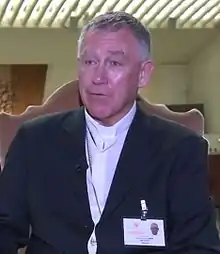
Just under half of the population at the 2013 census[60] declared an affiliation to Christianity. However, regular church attendance is probably closer to 15%.[61] Before European colonisation the religion of the indigenous Māori population was animistic, but the subsequent efforts of missionaries such as Samuel Marsden resulted in most Māori converting to Christianity.
Religious affiliation has been collected in the New Zealand census since 1851. One of the many complications in interpreting religious affiliation data in New Zealand is the large proportion who object to answering the question, roughly 173,000 in 2013. Most reporting of percentages is based on the total number of responses, rather than the total population.
References
- Australian Department of Immigration and Border Protection (2 January 2014). "Fact Sheet 17 – New Zealanders in Australia". Archived from the original on 12 February 2014. Retrieved 14 February 2014.
- John Bryant and David Law (September 2004). "New Zealand's Diaspora and Overseas-born Population: The diaspora". New Zealand Treasury. Archived from the original on 6 February 2018. Retrieved 10 August 2010.
- "Immigration and Ethnocultural Diversity Highlight Tables". Statistics Canada. Retrieved 13 June 2020.
- Matthew Chung (6 November 2009). "From F1 to Fifa, the show rolls on". The National. Archived from the original on 22 February 2014. Retrieved 11 August 2010.
- "Living in Hong Kong". New Zealand Ministry of Foreign Affairs and Trade. Retrieved 28 June 2017.
- "Anzahl der Ausländer in Deutschland nach Herkunftsland (Stand: 31. Dezember 2014)".
- "Pressemitteilungen - Ausländische Bevölkerung - Statistisches Bundesamt (Destatis)" (in German). Destatis.de. 2016-03-29. Retrieved 2017-06-28.
- https://quickstats.censusdata.abs.gov.au/census_services/getproduct/census/2016/quickstat/SSC90004?opendocument
- "2013 Census QuickStats about culture and identity – Religious affiliation". Stats NZ – stats.govt.nz. 15 April 2014. Retrieved 24 August 2017.
- Gary Morley (24 June 2010). "Kiwis hope to take flight at World Cup". CNN. Retrieved 11 August 2010.
- "Kiwi and people: early history". Te Ara: The Encyclopedia of New Zealand. Retrieved 11 August 2010.
- "Definition of 'kiwi'". Collins English Dictionary. Retrieved 28 July 2019.
- Gillian Smeith and Kim Dunstan (June 2004). "Ethnic Population Projections: Issues and Trends". Statistics New Zealand. Retrieved 10 August 2010.
- "Population estimate tables - NZ.Stat". Statistics New Zealand. Retrieved 22 October 2020.
- "Number of overseas-born tops 1 million, 2013 Census shows". Statistics New Zealand. 15 April 2014. Archived from the original on 30 July 2017. Retrieved 30 July 2017.
- TOTAL POPULATION BY ETHNIC ORIGIN, 1916-1971 The New Zealand population can broadly be classified, according to ethnic origin, into three main groups: Europeans, Maoris and "others"..(Page:53.)
- Total and Mäori Populations 1858–2001 Censuses of Population and Dwellings Statistics New Zealand
- 2013 Census QuickStats about culture and identity Archived 2015-01-15 at the Wayback Machine Available from stats.govt.nz.
- 2013 Census results: New Zealand
- Te Ara: The Encyclopedia of New Zealand: New Zealand Peoples Archived 2008-07-20 at the Wayback Machine
- Misa, Tapu (8 March 2006). "Ethnic Census status tells the whole truth". New Zealand Herald. Archived from the original on 12 April 2012.
- "Draft Report of a Review of the Official Ethnicity Statistical Standard: Proposals to Address the 'New Zealander' Response Issue" (PDF). Statistics New Zealand. April 2009. Retrieved 18 January 2011.
- Ranford, Jodie. "'Pakeha', Its Origin and Meaning". Māori News. Retrieved 20 February 2008.
Originally the Pakeha were the early European settlers, however, today 'Pakeha' is used to describe any peoples of non-Maori or non-Polynesian heritage. [...] It is merely a means by which the peoples of Aotearoa differentiate between the indigenous peoples and the early European Settlers, or the Maori and the other, irrelevant of race, colour, ethnicity, and culture.
- Mein Smith (2005), pg 23.
- King (2003) pg 122.
-
Belich, James (1996). Making Peoples: A History of the New Zealanders From Polynesian Settlement to the End of the Nineteenth Century. Auckland: Penguin (published 2007). ISBN 9781742288222. Retrieved 19 August 2019.
Old New Zealand did not finally fade away until the early twentieth century, but in the half-century before this it was largely transformed into what a later chapter will call 'crew culture'. This culture differed sharply from mainstream Pakeha society, shared many of the characteristics of the Old New Zealand Tasmen, and was their heir. But it tended more to miners and navvies than whalers and sealers; was much larger; worked more in tandem with mainstream Pakeha; and from the 1860s was increasingly disconnected from its old Maori partner.
- Political and constitutional timeline, New Zealand History online, Ministry for Culture and Heritage. Updated 6 December 2009. Retrieved 30 April 2010.
- "New Zealand Advertiser and Bay Of Islands Gazette". Hocken Library. 19 June 1840. Retrieved 22 April 2010.
- "History of Immigration - 1840 - 1852".
- "History of Immigration - 1853 - 1870".
- "1881–1914: restrictions on Chinese and others". Te Ara: The Encyclopedia of New Zealand.
- "Polish Orphans". Te Ara. 16 November 2012.
- Wilmshurst, J. M.; Hunt, T. L.; Lipo, C. P.; Anderson, A. J. (2010). "High-precision radiocarbon dating shows recent and rapid initial human colonization of East Polynesia". Proceedings of the National Academy of Sciences. 108 (5): 1815–20. Bibcode:2011PNAS..108.1815W. doi:10.1073/pnas.1015876108. PMC 3033267. PMID 21187404.
- Irwin, Geoff; Walrond, Carl (4 March 2009). "When was New Zealand first settled? – The date debate". Te Ara: The Encyclopedia of New Zealand. Retrieved 14 February 2010.
- Mein Smith (2005), pg 6.
- Lowe, David J. (2008). Lowe, David J. (ed.). Guidebook for Pre-conference North Island Field Trip A1 'Ashes and Issues' (28–30 November 2008). Australian and New Zealand 4th Joint Soils Conference, Massey University, Palmerston North (1–5 December 2008) (PDF). New Zealand Society of Soil Science. pp. 142–147. ISBN 978-0-473-14476-0. Retrieved 14 February 2010.
- Sutton et al. (2008), pg 109. "This paper ... affirms the Long Chronology [first settlement up to 2000 years BP], recognizing it as the most plausible hypothesis."
- Clark (1994) pg 123–135
- Davis, Denise (11 September 2007). "The impact of new arrivals". Te Ara: The Encyclopedia of New Zealand. Retrieved 30 April 2010.
- Hare, McLintock, Alexander; Gully, John Sidney (1966). "The Word 'Maori'". An Encyclopaedia of New Zealand. Retrieved 5 May 2017.
- "Parihaka Attack". Ministry for Culture and Heritage. Retrieved 5 May 2017.
- "Māori - Urbanisation and renaissance". Te Ara: The Encyclopedia of New Zealand. Retrieved 5 May 2017.
- "Ethnic group (detailed single and combination) by age group and sex, for the census usually resident population count, 2013 -- NZ.Stat". Statistics New Zealand. Retrieved 16 August 2014.
- Hamer, Paul (2012), Māori in Australia: An Update from the 2011 Australian census and the 2011 New Zealand General Election, SSRN 2167613
- "Sharples suggests Maori seat in Australia". Television New Zealand. 1 October 2007. Retrieved 9 January 2011.
- Walrond, Carl (4 March 2009). "Māori overseas". Te Ara: The Encyclopedia of New Zealand. Retrieved 7 December 2010.
- New Zealand-born figures from the 2000 U.S. Census; maximum figure represents sum of "Native Hawaiian and Other Pacific Islander" and people of mixed race. United States Census Bureau (2003)."Census 2000 Foreign-Born Profiles (STP-159): Country of Birth: New Zealand" (PDF). (103 KB). Washington, D.C.: U.S. Census Bureau.
- "Pacific Islands and New Zealand". Te Ara: The Encyclopedia of New Zealand. Retrieved 5 May 2017.
- 2013 Census tables about a place: New Zealand Archived 2016-03-25 at the Wayback Machine Ethnic groups of people in New Zealand
- "The people of New Zealand". TeAra.govt.nz. Te Ara: The Encyclopedia of New Zealand. Retrieved 28 June 2017.
- "About the Waitangi Tribunal". waitangitribunal.govt.nz. Waitangi Tribunal. Retrieved 28 June 2017.
- "The Spirit of ANZAC". ANZAC Day Commemoration Committee. 26 November 2015. Retrieved 28 June 2017.
- "Make your overseas experience relevant to New Zealand". newzealandnow.govt.nz. New Zealand Immigration. Retrieved 28 June 2017.
- "Australia and New Zealand - Common culture". Te Ara: The Encyclopedia of New Zealand. Retrieved 28 June 2017.
- Haerewa, Ngarangi. "Māori Culture: What Is A Pōwhiri?". Culture Trip. Retrieved 28 June 2017.
- Gray, Mel; Coates, John; Bird, Michael Yellow (2008). Indigenous Social Work Around the World: Towards Culturally Relevant Education and Practice. Ashgate Publishing, Ltd. p. 114. ISBN 9780754648383.
- Wolfe, Richard (July–September 1994). "Zealandia – mother of the nation?". New Zealand Geographic. No. 23. Auckland. Retrieved 5 June 2017.
- Denis James Matthews Glover, "A National Symbol?" in An Encyclopaedia of New Zealand (A. H. McLintock ed, 1966). Retrieved on 5 June 2017.
- National Arms of New Zealand - Heraldry of the World. Last modified on 21 January 2016. Retrieved on 5 June 2017.
- Table 28, 2013 Census Data – QuickStats About Culture and Identity – Tables.
- Opie, Stephen (June 2008). Bible Engagement in New Zealand: Survey of Attitudes and Behaviour (PDF). Bible Society of New Zealand. p. 4. Archived from the original (PDF) on 26 May 2010. Retrieved 29 May 2010.
External links
| Wikimedia Commons has media related to People of New Zealand. |
- Demographics of New Zealand’s Pacific Population—Statistics New Zealand
- Population clock—Statistics New Zealand
.jpg.webp)